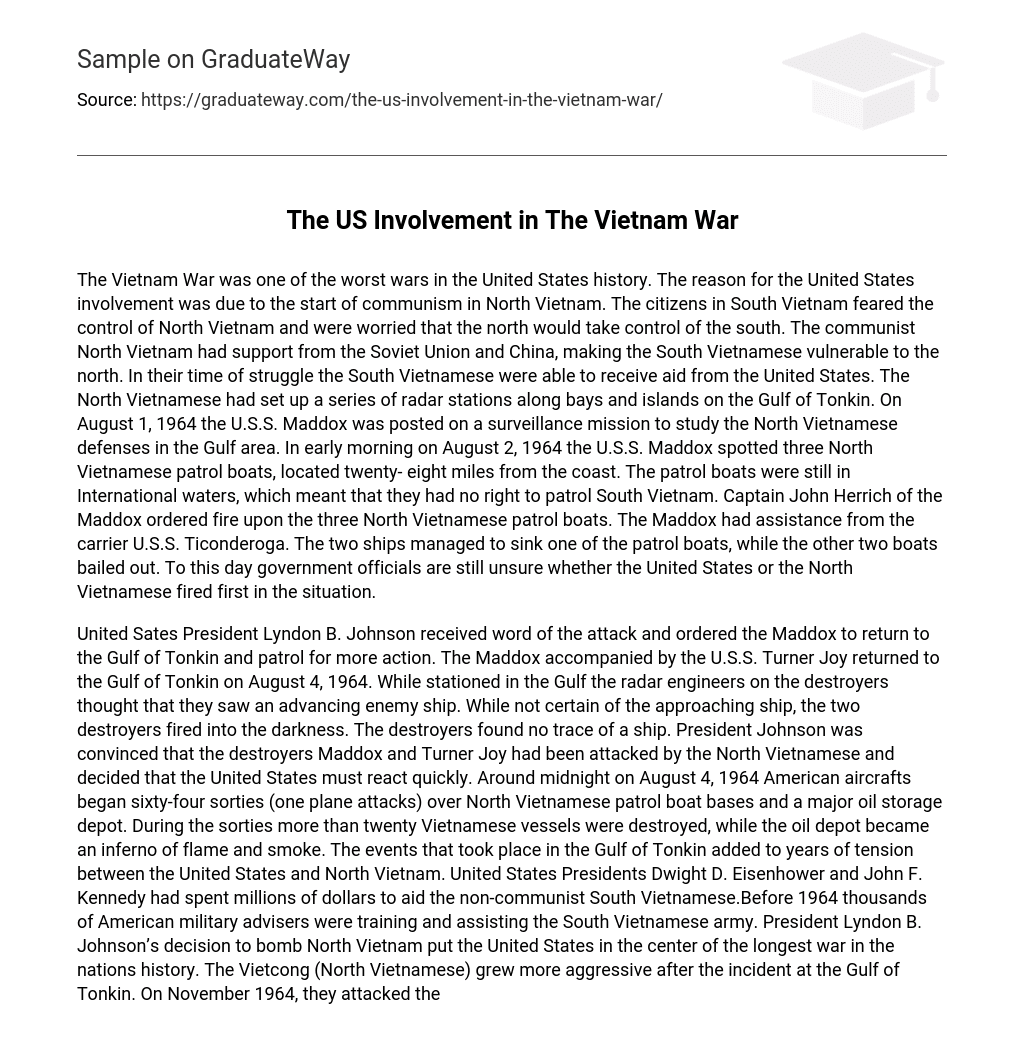The reason for the United States’ involvement in the Vietnam War was due to the rise of communism in North Vietnam, which posed a threat to South Vietnam. The people of South Vietnam feared being controlled and taken over by the north. To support them during their struggle, the United States provided assistance to South Vietnam. In contrast, with support from the Soviet Union and China, North Vietnam established radar stations in the Gulf of Tonkin area.
To assess North Vietnamese defenses in that region, on August 1, 1964, the U.S.S. Maddox was sent on a surveillance mission. On August 2, 1964, approximately twenty-eight miles off the coast in international waters, three North Vietnamese patrol boats were spotted by the U.S.S. Maddox. These patrol boats had no authority to patrol South Vietnam; therefore Captain John Herrich of the Maddox ordered an attack on them.
The Maddox and the carrier U.S.S. Ticonderoga collaborated, causing one of the patrol boats to sink and forcing the other two to flee. It remains uncertain who initiated the attack, whether it was the United States or North Vietnam. President Lyndon B. Johnson instructed the Maddox to go back to the Gulf of Tonkin for further patrolling after being informed about this incident. On August 4, 1964, accompanied by the U.S.S. Turner Joy, the Maddox returned to the Gulf of Tonkin where radar engineers on board detected a potential approaching enemy ship. Both destroyers fired into darkness but found no evidence of any ship presence. President Johnson believed that North Vietnam had attacked both Maddox and Turner Joy and deemed a swift response necessary from America.
On August 4, 1964, American aircraft conducted sixty-four sorties over North Vietnamese patrol boat bases and a major oil storage depot. During these sorties, more than twenty Vietnamese vessels were destroyed and the oil depot became engulfed in flames and smoke. These events heightened the tension between the United States and North Vietnam.
The escalation of aggression started with Presidents Dwight D. Eisenhower and John F. Kennedy providing significant financial aid to South Vietnam, which opposed communism, as well as deploying numerous American military advisers for training their army.
However, it was President Lyndon B. Johnson’s decision to bomb North Vietnam that led the United States into its longest war ever. The Gulf of Tonkin incident further incited the Vietcong (North Vietnamese), who attacked Bien Hoa, an American base in November 1964 resulting in five B-57 jets being destroyed and damage to twenty more.
Tensions between the Vietcong escalated, leading to an increase in draft calls and widespread American casualties. The bombing of Saigon’s Brinks Hotel by the Vietcong on Christmas Eve of 1964 resulted in the death of two American officers and injuries to fifty-eight others. In response, on February 7th, 1965, the Vietcong attacked an American fort near Pleiku in South Vietnam’s mountains. In retaliation, American jets launched airstrikes on North Vietnamese camps at Dong Hoi. These events marked the initiation of Operation Rolling Thunder, a large-scale series of air strikes conducted by the United States.
On February 22nd, 1965, General William Westmoreland made a request for two battalions of US Marines to protect the American base located in Da Nang.
In March 1965, the U.S. Marines arrived in Da Nang to fight against the Vietcong, marking their return to Asia for the first time since the Korean War. More American soldiers were sent to Vietnam on a weekly basis, and by December, their numbers exceeded two hundred thousand.
The U.S. adopted a strategy of intense bombing using B-52 jets and conducted search and destroy missions in South Vietnam’s jungles and villages. The Vietcong relied on guerrilla tactics in the jungle terrain and set traps for the foreign troops.
Explosive material including Napalm was dropped by U.S. B-52 bombers on North Vietnam during March 1965. Throughout June, approximately 4,800 U.S. attacks were carried out on targets in North Vietnam. Before early 1967, twelve thousand bombing missions each month targeted various locations carried out by U.S. bombers.
During Operation Rolling Thunder, the US dropped a greater number of bombs on North Vietnam than it did on all of Europe during WWII. The objective was to annihilate North Vietnamese supplies; however, the Vietcong relied minimally on supplies for their Guerrilla warfare strategies. Nevertheless, these raids were ineffective against the Vietcong. Throughout the bombing campaigns, Vietcong soldiers resided in mountains, subsisting on rice and sleeping on the ground without luxuries. Conversely, the US possessed ample resources including abundant funds and cutting-edge technology. American soldiers carried fully automatic M-16 rifles while helicopters, fighter planes, and bombers filled the skies. Furthermore, along water routes there were destroyers, tankers, and patrol boats.
They provided medicines, surgical equipment, packaged food, and other vital items. On average, each U.S. soldier received one hundred pounds of supplies per day, while the Vietcong received nothing. The United States extensively developed South Vietnam through the construction of roads, bridges, airstrips, and more. Cafes became gathering places, and women resorted to prostitution for income. Fishing ports were transformed into deep harbors for U.S. warships. Despite the generous financial investment from the United States, it ultimately proved futile. The Vietcong thrived without any of these resources and demonstrated their ability to overpower the United States.
Bibliography:





